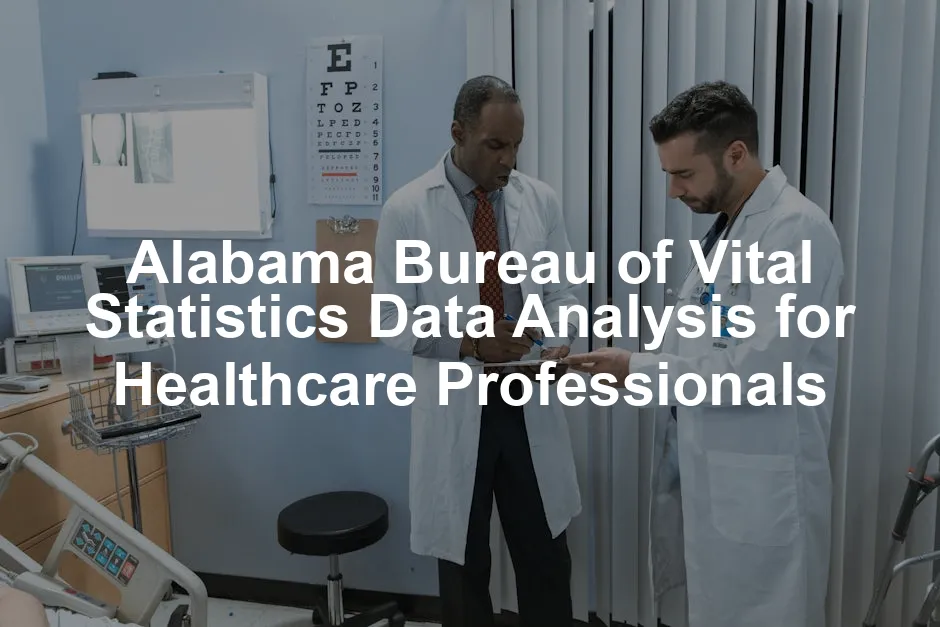Introduction
In the ever-evolving world of healthcare, data is the new goldmine. For professionals navigating the complex landscape of public health, understanding vital statistics is crucial. Welcome to your guide on the Alabama Bureau of Vital Statistics! This article highlights the wealth of data available, from birth and death rates to marriage and divorce statistics. These insights inform healthcare policy, improve patient care, and enhance community well-being.
Forget the monotony of paperwork; this is where numbers meet narratives. Whether you’re a seasoned healthcare provider or a curious newcomer, transforming raw data into actionable insights is vital. The Alabama Bureau of Vital Statistics offers a treasure trove of information. But how can you leverage this data to enhance your practice?
Imagine using birth statistics to identify at-risk populations. What about analyzing death rates to pinpoint healthcare gaps? By understanding these statistics, healthcare professionals can make impactful changes in their communities. So, grab your calculators! Let’s make sense of Alabama’s vital statistics together. With data at your fingertips, you can become a champion of informed healthcare decisions.
In this article, we’ll guide you through the various data types available from the Bureau. We’ll explore how these statistics can shape healthcare practice and policy. Plus, you’ll learn how to access this information effectively. The journey from data to decision-making starts here. Let’s dive in!

Summary
This article aims to illuminate the significance of Alabama’s Bureau of Vital Statistics for healthcare professionals. We will offer a detailed analysis of the various data types available and their implications for health policy and practice. Key points include:
- Overview of Vital Records: A breakdown of the types of vital records maintained by the Alabama Bureau of Vital Statistics, including birth, death, marriage, and divorce certificates.
- Importance of Health Statistics: Discussion on how these records contribute to public health surveillance, policy-making, and understanding demographic changes.
- Data Access and Use: Instructions on how healthcare professionals can access and utilize this data, including online platforms and tools.
- Case Studies: Real-world examples of how vital statistics have influenced healthcare decisions and outcomes in Alabama.
- Future Trends: Insights into emerging trends in data collection and analytics, and how healthcare professionals can stay ahead in utilizing these developments for improved health outcomes.
By the end of this article, readers will not only understand the breadth of data available but also feel empowered to leverage this information in their practice, advocacy, and community health initiatives. With knowledge comes the responsibility to act, and the data from the Alabama Bureau of Vital Statistics is your ally in creating healthier communities.

Vital Records in Alabama
Overview of the Vital Records System
The Alabama Bureau of Vital Statistics is a gem in the state’s public health landscape. Established to keep a close eye on vital events, it handles crucial records like births, deaths, marriages, and divorces. This system isn’t just a bureaucratic requirement; it’s a vital component of public health monitoring and legal documentation.
Historically, the state has recognized the importance of these records. They provide a foundation for understanding demographic trends and health patterns. The Bureau gathers this data, ensuring that each record is accurately filed, stored, and made accessible when needed. This process is essential for maintaining public health surveillance and creating legal documents that citizens rely on for various purposes, such as obtaining driver’s licenses or applying for social security benefits.
By operating efficiently, the Bureau aids in tracking health trends, detecting outbreaks, and informing policy decisions. Simply put, without this vital records system, we would be navigating the healthcare landscape blindfolded!

Types of Vital Records Available
The Alabama Bureau of Vital Statistics offers several key documents that are crucial for healthcare providers and researchers alike.
- Birth Certificates: These documents are like the first chapter of a person’s health story. They provide essential information for healthcare providers, helping to establish identity and eligibility for services. Birth certificates also help track trends in natality, such as changes in birth rates and demographics over time. This data can significantly influence healthcare planning and resource allocation. Don’t forget to keep your important documents safe with a Birth Certificate Holder.
- Death Certificates: These records reveal mortality rates and causes, acting as a valuable tool for epidemiologists and healthcare professionals. Understanding the leading causes of death can guide public health initiatives and resource distribution. For instance, if heart disease tops the list, health authorities can ramp up awareness campaigns and preventive measures. Make sure to preserve these important documents with a Death Certificate Holder.
- Marriage and Divorce Certificates: These certificates go beyond legal documentation. They serve as indicators of family stability and can impact family health services. For instance, understanding marriage and divorce rates helps healthcare providers identify potential stressors in family dynamics that could affect mental health and wellness. If you’re navigating these transitions, consider keeping your documents organized with a Marriage Certificate Holder or a Divorce Certificate Holder.

Accessing Vital Records
Obtaining vital records in Alabama is designed to be straightforward. You can request these records online, through county health departments, or by mailing in a request. The Bureau has streamlined this process, often allowing you to receive records within 30 minutes through local health departments.
If you prefer online services, companies like VitalChek can expedite your request, albeit for an additional fee. However, be prepared for some waiting if you choose to mail your request—typically, you can expect a turnaround of 7 to 10 days.
Costs for obtaining records vary. Birth and death certificates generally range from $15 to $25. It’s wise to check the current fees on the Alabama Department of Public Health’s website to avoid any surprises.
So, whether you’re a healthcare provider, a researcher, or just someone curious about family history, accessing Alabama’s vital records is a breeze. With just a few clicks or a short visit, you’ll have valuable insights at your fingertips!
In summary, the Alabama Bureau of Vital Statistics plays a critical role in maintaining public health and legal documentation through vital records. Understanding the types of records available and how to access them can empower healthcare professionals to make informed decisions that ultimately benefit the communities they serve.

Case Studies: Vital Statistics Impact
Case Study 1: Maternal Health Initiatives
In Alabama, the data on birth rates and maternal mortality has sparked significant public health interventions. The state faced alarming maternal mortality rates, prompting healthcare professionals to take action. By analyzing this data, they unveiled trends showing disparities in care access among different demographics.
In response, Alabama launched initiatives focusing on education and access to prenatal care. Programs like “Mom’s Meals” and community health worker outreach targeted at-risk populations. The Bureau’s statistics acted as a guiding compass, steering resources toward regions with the highest needs. This data-driven approach has led to a decline in maternal mortality rates, showcasing the power of statistics in shaping effective health policies.
Moreover, collaboration between hospitals improved care coordination. By using birth data, healthcare providers could identify high-risk pregnancies and allocate resources accordingly. This collaboration not only enhanced maternal care but also fostered trust in the healthcare system. The positive changes in maternal health outcomes truly illustrate how vital statistics can influence public health initiatives.

Case Study 2: Managing Public Health Crises
The COVID-19 pandemic brought unprecedented challenges, and Alabama’s response heavily relied on death statistics. When the virus struck, rapid data analysis became crucial. The Bureau’s timely death statistics provided a clear picture of the pandemic’s impact across the state.
By closely monitoring mortality data, healthcare leaders identified trends in infection rates and mortality, enabling them to adjust policies effectively. For instance, areas with rising death counts received increased healthcare resources, while targeted outreach was implemented in communities most affected.
This data-driven response allowed for informed decision-making, resulting in more efficient vaccine distribution and public health messaging. As a result, communities were better prepared to handle the crisis. This case underscores the essential role of vital statistics in managing public health emergencies and guiding healthcare responses.

Case Study 3: Community Health Programs
Marriage and divorce statistics may seem unrelated to health, but in Alabama, they significantly influence local health service planning. Understanding family dynamics helps healthcare professionals identify health needs within communities. The Bureau’s statistics revealed trends that prompted tailored health initiatives addressing mental health, family counseling, and support services.
For instance, rising divorce rates in certain counties led to increased demands for mental health services. In response, healthcare providers collaborated with community organizations to create accessible support systems, such as counseling services and family therapy programs. These initiatives not only addressed immediate needs but also fostered long-term community wellness.
Additionally, marriage statistics provided insights into family health patterns, enabling healthcare initiatives to focus on preventive care. By targeting families with educational resources on health and wellness, Alabama’s healthcare professionals are paving the way for healthier generations. This innovative use of marriage and divorce data illustrates the unexpected yet impactful ways vital statistics can shape community health services.

Future Trends in Vital Statistics
Emerging Technologies in Data Collection
The future of vital statistics in Alabama is bright, with emerging technologies enhancing data accuracy and accessibility. Electronic verification systems, like the Vital Statistics Image Oriented Network (ViSION), are revolutionizing how vital records are collected and managed. By digitizing this process, the state can issue records more efficiently, reducing wait times significantly.
These technological advancements increase the reliability of data, ensuring healthcare professionals have access to the most current information. Moreover, as data becomes more accessible, healthcare providers can better track health trends, leading to more effective interventions. This shift toward technology promises a more robust vital statistics system, benefiting public health initiatives across Alabama.

Predictive Analytics in Healthcare
The integration of predictive analytics into healthcare is set to transform how vital statistics are utilized. By harnessing the power of data modeling, healthcare professionals can anticipate trends and health outcomes more effectively. For example, predictive models can analyze historical birth and death data to identify patterns that may signal a future public health crisis.
This proactive approach allows for strategic planning and resource allocation, ensuring that healthcare systems are prepared for potential challenges. Furthermore, predictive analytics can enhance patient care by identifying at-risk populations, leading to timely interventions. As Alabama embraces these advanced analytics techniques, the potential for improved health outcomes grows exponentially.

The Role of Healthcare Professionals in Data Utilization
Healthcare professionals play a critical role in the effective utilization of vital statistics. To maximize the benefits of this data, they must adopt strategies that foster collaboration and continuous learning. Regular training sessions on data interpretation can equip providers with the skills needed to analyze trends and make informed decisions.
Additionally, engaging in community partnerships can enhance data collection efforts. By working together with local organizations, healthcare professionals can share insights and resources, creating a comprehensive approach to health service planning. Ultimately, the successful integration of vital statistics into practice depends on the commitment and collaboration of healthcare professionals across Alabama. By embracing data-driven strategies, they can lead the charge toward a healthier future for all communities.

Conclusion
In summary, the Alabama Bureau of Vital Statistics plays a vital role in shaping the healthcare landscape of the state. It provides essential data that influences healthcare practices, policies, and community health initiatives. For healthcare professionals, leveraging this data is not just beneficial; it’s crucial for improving patient outcomes and addressing public health challenges.
The data gathered by the Bureau informs us about demographic shifts and health disparities. For instance, birth and death statistics help identify at-risk populations and potential healthcare gaps. By understanding these figures, healthcare providers can tailor their services to meet community needs effectively.
Furthermore, the Bureau’s data serves as a foundation for policy-making. It aids in crafting strategies that enhance public health initiatives, ensuring resources are allocated where they are most needed. As we navigate the complexities of healthcare delivery, data-driven decision-making becomes increasingly important.
As we look to the future, it is clear that embracing data analytics will be pivotal in shaping a healthier Alabama. Healthcare professionals must prioritize utilizing this wealth of information to inform their practices. By doing so, they can contribute to a more informed, healthier community. The journey towards better health outcomes starts with understanding the statistics that tell our story.

FAQs
What types of data can I find from the Alabama Bureau of Vital Statistics?
The Alabama Bureau of Vital Statistics provides a variety of data, including birth, death, marriage, and divorce statistics. These records are essential for understanding public health trends and demographic changes within the state.
How can I access vital records?
You can access vital records through several methods. Online requests can be made via independent services like VitalChek. Alternatively, you can visit your local county health department, or submit a request by mail. Typically, online requests are processed quickly, often within 30 minutes, while mailed requests may take 7 to 10 days.
Why are health statistics important for healthcare professionals?
Health statistics are crucial for healthcare professionals as they guide public health policy, enhance patient care, and inform resource allocation. By analyzing these statistics, practitioners can identify health trends and disparities, leading to better-targeted interventions and improved health outcomes.
Are there costs associated with obtaining vital records?
Yes, there are fees associated with obtaining vital records in Alabama. Generally, the cost for birth and death certificates ranges from $15 to $25. It’s recommended to check the Alabama Department of Public Health’s website for the most up-to-date fee information.
How can I utilize statistical tools for my practice?
Healthcare professionals can utilize the Statistical Query System to access and interpret vital statistics data effectively. This tool allows users to create custom tables based on various criteria, such as birth or death rates, helping practitioners make informed decisions.
What are the challenges in using vital statistics data?
While vital statistics data is invaluable, there are challenges in its use. Issues may arise regarding data accuracy, accessibility, and interpretation. Ensuring that the data is current and accurately reflects the population is essential for making informed healthcare decisions.
Health Statistics Data Analysis
Importance of Health Statistics for Healthcare Professionals
Health statistics are the backbone of effective healthcare. They guide public health policy, resource allocation, and clinical practices. For healthcare professionals, understanding these figures is crucial. They help identify trends, pinpoint health disparities, and shape interventions.
In Alabama, data from the Bureau of Vital Statistics provides insights into risk factors and community needs. For instance, knowing the rates of infant mortality can lead to targeted maternal health initiatives. If death rates spike in a particular demographic, resources can be directed accordingly. This aligns with the importance of health statistics for informed healthcare decisions.
Accessing health statistics is essential for understanding community health needs. Learn more about statistics for healthcare professionals.
Moreover, health statistics inform decisions on funding and program development. By analyzing data, healthcare leaders can make informed choices that ultimately enhance patient care. This data-driven approach is essential for addressing public health challenges effectively.

Key Health Data Provided
The Alabama Bureau of Vital Statistics offers a treasure trove of health data. Key statistics include:
- Natality Statistics: Understanding birth rates helps healthcare systems plan for maternal and child health services. This data indicates how many births occur and the conditions surrounding them.
- Pregnancy Data: Information on pregnancy outcomes, including live births and stillbirths, informs prenatal care programs.
- Mortality Rates: Tracking causes of death reveals patterns essential for public health surveillance. For example, if heart disease is prevalent, health officials can implement prevention strategies.
- Infant Mortality Statistics: These figures are particularly telling. They reflect the overall health of a community and can highlight disparities in care access.
- Demographic Factors: Age, race, and socio-economic status impact health outcomes. Analyzing these factors helps tailor healthcare services to meet diverse community needs.

Tools for Data Analysis
Healthcare professionals in Alabama can utilize various tools for analyzing vital statistics. The Statistical Query System stands out. This web-based tool allows users to create custom tables based on selected criteria. Want to know the birth rate in a specific county? You can do that!
Additionally, the Bureau provides downloadable data files for independent research. These resources enable healthcare professionals to conduct their analyses, leading to deeper insights into local health trends.
Real-life examples illustrate the impact of these tools. For instance, a local health department used mortality data to identify trends in drug overdoses. This analysis led to the implementation of targeted prevention programs, ultimately saving lives. For more tips on effective data analysis, check out tips for effective data analysis.
In summary, health statistics are vital for healthcare professionals. They not only inform policy and practice but also empower communities. By harnessing the data provided by the Alabama Bureau of Vital Statistics, healthcare workers can drive meaningful change and improve public health outcomes across the state.
For those looking to stay organized in their health journey, consider using a Personal Health Journal to track your data and health trends easily!
Please let us know what you think about our content by leaving a comment down below!
Thank you for reading till here 🙂
All images from Pexels




